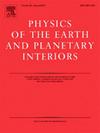利用接收函数的谐波分解研究印度东北部地震地壳各向异性和地壳下变形
IF 1.9
3区 地球科学
Q2 GEOCHEMISTRY & GEOPHYSICS
引用次数: 0
摘要
印度东北部地震活动活跃,构造构造复杂,俯冲作用持续,岩性构造多样,是各向异性研究的重要天然实验室。本研究通过对该地区10个宽带地震台站记录的远震接收函数进行谐波分解(HD),分析了岩石圈各向异性。我们的研究结果表明,在不同的构造影响下,东喜马拉雅山脉、阿萨姆山谷、西隆高原和孟加拉盆地的地壳变形存在显著差异。我们在印度-缅甸和东喜马拉雅地区观测到的莫霍深度约为50-60公里,在阿萨姆山谷约为30-40公里,在西隆高原约为37公里,在孟加拉盆地约为43 - 47公里。此外,快速各向异性轴线的走向一般跟随印度板块(N200E)的运动,在Kopli断裂带和印缅地区附近有局部偏差,表明构造复杂性复杂。而上地幔各向异性轴向由N200W向E-W变化。邻近各向异性界面及其倾斜轴的变化反映了与俯冲和碰撞构造有关的广泛地壳变形。值得注意的是,东喜马拉雅在东西向表现出格点优先排列,而莫霍深度从北到南的增加强调了与地幔向下弯曲相关的持续碰撞和地壳增厚的影响,特别是在西隆高原和孟加拉盆地等地区。同时存在较浅的莫霍面和垂直于各向异性倾斜方向(E-W)的应力,验证了构造支撑的西隆高原隆升假说。这些发现强调了软流圈流动和跨地壳增厚在塑造印缅山脉地壳结构中的作用,这是由于地壳下动力学过程,以及孟加拉盆地沉降和沉积物沉积的额外影响。观测到的各向异性与过去印度板块运动一致,而特里普拉褶皱带的变化表明地幔流与区域构造之间存在复杂的相互作用。本文章由计算机程序翻译,如有差异,请以英文原文为准。

Investigating seismic crustal anisotropy and sub-crustal deformation beneath Northeast India through harmonic decomposition of receiver functions
Northeast India, characterized by its active seismicity, complex tectonic structures, ongoing subduction, and diverse lithological formations, serves as an important natural laboratory for anisotropic studies. This study analyzed lithospheric anisotropy through the Harmonic Decomposition (HD) of receiver functions derived from teleseismic earthquakes recorded at ten broadband seismic stations across the region. Our findings reveal significant variations in crustal deformation across the Eastern Himalayas, Assam Valley, Shillong Plateau, and Bengal Basin, driven by distinct tectonic influences. We observed a Moho depth of approximately 50–60 km in the Indo-Burma and Eastern Himalayan regions, around 30–40 km in the Assam Valley, about 37 km in the Shillong Plateau, and between 43 and 47 km in the Bengal Basin. Further, the alignment of fast anisotropic axes generally follows the motion of the Indian Plate (N200E), with localized deviations near the Kopli Fault and Indo-Burma region, indicating intricate tectonic complexities. However, the anisotropy axis direction varies from N200W to E-W in the uppermost mantle. The adjacent variations in anisotropic interfaces and their tilt axes across these regions reflect extensive crustal deformation associated with subduction and collision tectonics. Notably, the Eastern Himalayas exhibit a lattice-preferred alignment in the E-W direction, while the increasing Moho depth from north to south underscores the effects of ongoing collision and crustal thickening associated with down warping of the mantle, particularly in areas like the Shillong Plateau and Bengal Basin. The simultaneous presence of shallower Moho and stress perpendicular to anisotropic tilt direction (E-W) discerned in this study validates the hypothesis of a tectonically supported uplifted Shillong Plateau. These findings highlight the role of asthenosphere flow and transpressional thickening in shaping the crustal structure in the Indo-Burma ranges due to sub-crustal geodynamical processes, with additional influences from subsidence and sediment deposition in the Bengal Basin. The observed anisotropy is consistent with past Indian plate motion, while variations in the Tripura fold belt suggest complex interactions between mantle flow and regional tectonics.
求助全文
通过发布文献求助,成功后即可免费获取论文全文。
去求助
来源期刊

Physics of the Earth and Planetary Interiors
地学天文-地球化学与地球物理
CiteScore
5.00
自引率
4.30%
发文量
78
审稿时长
18.5 weeks
期刊介绍:
Launched in 1968 to fill the need for an international journal in the field of planetary physics, geodesy and geophysics, Physics of the Earth and Planetary Interiors has now grown to become important reading matter for all geophysicists. It is the only journal to be entirely devoted to the physical and chemical processes of planetary interiors.
Original research papers, review articles, short communications and book reviews are all published on a regular basis; and from time to time special issues of the journal are devoted to the publication of the proceedings of symposia and congresses which the editors feel will be of particular interest to the reader.
 求助内容:
求助内容: 应助结果提醒方式:
应助结果提醒方式:


